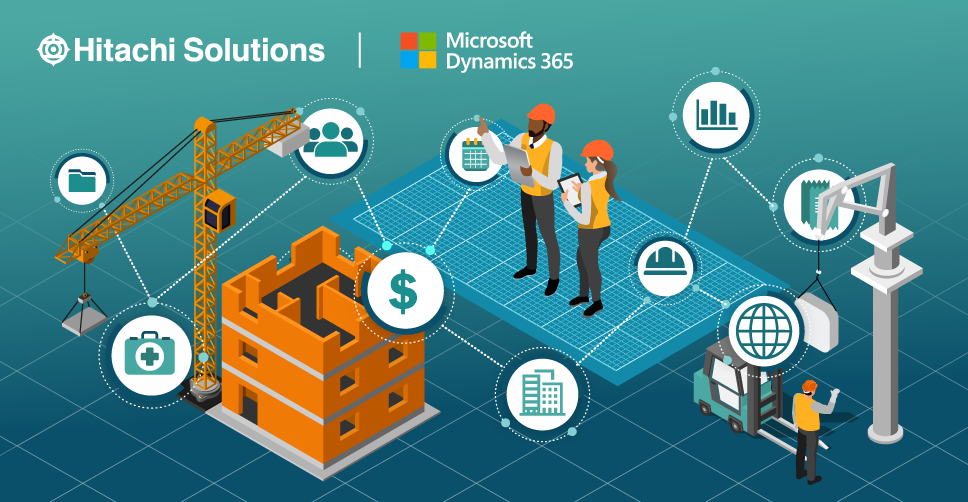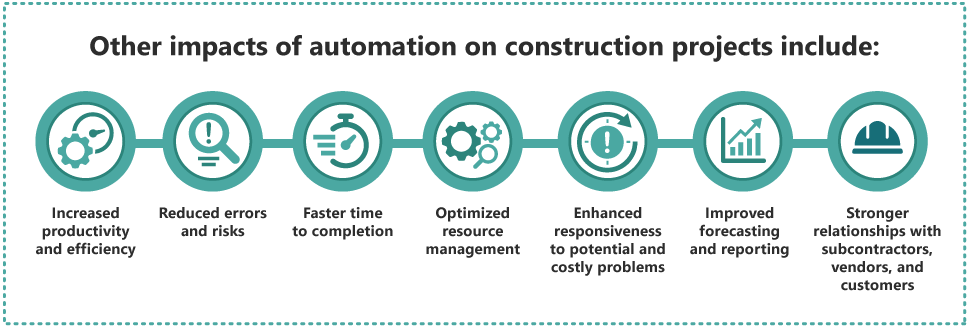

11 Key Success Factors Affecting Project Automation
In light of heightened uncertainty and erratic economic variables, project services must be efficient and flexible - are you prepared?
Download the EbookThe construction industry is slowly bouncing back after a hard couple of years. And although it’s one of the largest sectors of the U.S. economy ($1.589 trillion in revenue in 2021 and employing 7.5 million people), it still faces several ongoing challenges — including skilled labor shortages, supply chain, and material sourcing issues, rising inflation, and interest rates, and overall global instability, to name a few.
Despite these challenges, the demand for construction projects continues to grow. But costs are high, resources scarce, and delays are around every corner. To be profitable today, companies have to be resilient, agile, and efficient.

The good news is, innovations in digital construction and construction project management automation continue to evolve and become more accessible, even to an industry that is traditionally slow to adopt new technology and change. While always people-first focused, project services automation is one of the best ways to offset construction challenges and help companies adapt to the “new normal” in the industry.
The Benefits of Project Services Automation
Construction projects can be large and complex, with lots of moving parts. Many of the tasks are manual and process paper-based. This can breed inaccuracy, redundancy, and inefficiency — something you can’t afford right now.
Project service automation (PSA) solutions — such as Microsoft Dynamics 365 Project Service Automation) — unify project data, standardize and streamline processes and tasks, and align sales and service delivery. It reduces the chaos by providing a collaborative environment for working faster and smarter. Everyone has access to the same information, plans, tasks, dates, resources, and more.
Having the ability to track, manage, and control projects centrally — from sales through to invoicing — ensures projects are delivered on time and on budget.

11 Success Factors Affecting Project Automation
Cloud computing, IoT, AI, machine learning, mobility, and other smart technologies exploded during the pandemic, helping companies continue to serve customers while also optimizing operations, enhancing services, and boosting revenue. Now that these technology trends have taken hold, they are powering even more PSA innovation.
In our new ebook, 11 Key Success Factors Affecting Project Automation, we leverage our deep knowledge and expertise to identify the top technology trends that we feel are vital to project services’ success in the future.
Take a look! We highlight some of the most exciting technologies and solutions that are reshaping the industry and creating opportunities for project-based companies to be more cost-effective and responsive to customer demands. For example:
- Machine Learning Resource Management — Companies are now fueling their PSA solutions with machine learning to recommend the right resources for the right work based on updated skills and availability. Also, they are using machine learning to gain insights for more accurate and meaningful forecasting.
- Single-Platform Solutions — Most companies have old, disparate legacy systems for running their business. Today, you want a one-stop service provider to manage your complete customer experience — from deployment through implementation, support, and upgrades. The benefits of a single-platform solution include greater integration, faster data flow, lower costs, improved visibility, and increased productivity.
- Customer Data Management — Building a seamless customer experience is just as important as successfully completing a project. The use of a customer data platform (CDP) can unify and clean your business data — and eliminate silos — to help create a single, 360-degree view of every customer. This helps companies understand their customers and provide better service and support.
- Project Planning — Advances in project planning tools have made it easier than ever for sales and project managers to visualize cost, effort, and value to estimate and define work. This enables them to create bids more effectively, reduce the cost of sales, and keep project planning expenses low.
- Vendor Onboarding and Collaboration — About 50 percent of a vendor’s time at a site is spent doing paperwork. The use of automation technology can help streamline the process and successfully onboard a vendor before they even set foot on a job site. This improves efficiency, accuracy, and enables better communication throughout the project lifecycle.
Download the ebook to dig even deeper into these trends, and discover several other must-have solutions including IoT and field service, big data and analytics, remote collaboration, customer billing, and safety inspections. All of these trends are critical to getting the most value and benefit from your project services automation — and really all your technology — investments.
A History of Building Value
For over a decade, Hitachi Solutions has empowered construction organizations around the world to enhance their technological infrastructures. From connected, cloud-based construction management solutions to PSA solutions to onsite mobile applications, our technology, and integration with Microsoft solutions are helping more construction companies stay on top of an ever-changing landscape.
Feel free to reach out to talk to our experts about any of the project services automation solutions in the ebook, or if you have any questions regarding digital transformation or Microsoft solutions for business and data modernization. Our experts are waiting!


